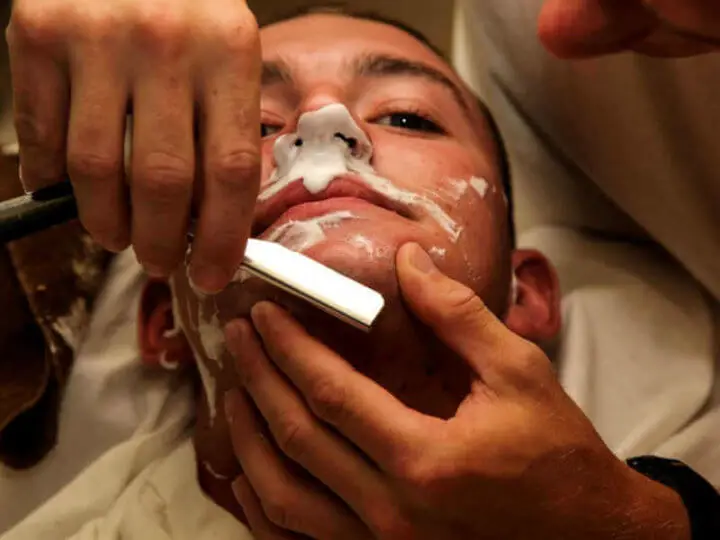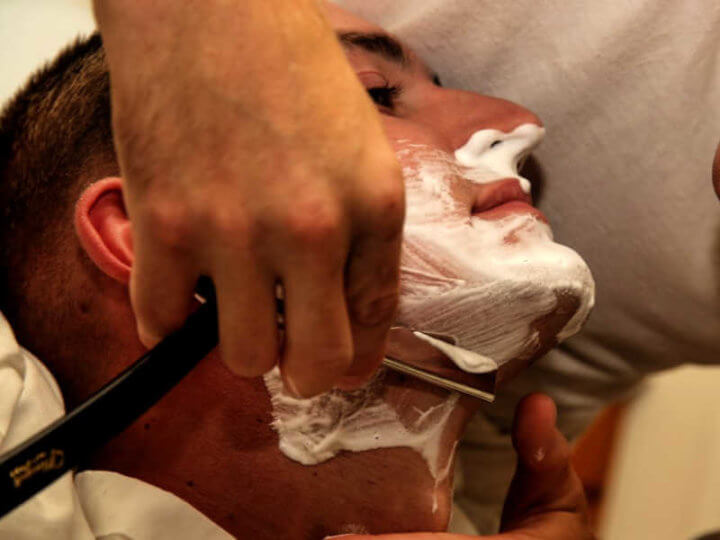
[Editor’s note: Cait is a barber who recently wrote of her experience as a female barber in a “man’s” profession. Sharpologist asked her to discuss how she learned to shave as a barber.] One of the key tenets of men’s grooming is the classic straight-razor shave. For many men, it beckons memories of lying back in a luxurious leather chair, a hot, steaming towel over your face, a badger-hair brush working thick, creamy lather into your skin, the bitter-sweet scent of bay rum, and the soft scraping sounds of the beard hair being whisked away. For those of you who have never enjoyed the experience of a straight-razor shave before, what are you waiting for? It’s a staple of men’s grooming and lifestyle, and an experience that all men should have at least once.
But learning to shave takes time. It’s an art, one that comes with challenges, as any art form does, but also comes with risks. It is, after all, a blade being held against your throat, but as long as the barber wielding the razor has a good amount of experience under their belt, you don’t need to worry.
The Learning Curve: How Do Barbers Get Their Experience?
Where do we get that experience? How do barbers learn to shave? I’m sure you’ve heard that in school, many barbers practice by shaving balloons. If you’re holding your razor correctly and have proper stroking technique, the balloon shouldn’t pop. I was never taught that way. In fact, I don’t know many barbers who were. The way I learned was practicing over and over on a subject without a blade in my razor, until I had the movements down to a science.
Once I had that covered, I began to shave my arms and legs with my straight razor. Most men going through barber training aren’t going to do that, but I do think it’s an excellent way to get practice, and I think more guys should give it a shot, especially since you are your own subject, and you can tell how your strokes and techniques feel when you’re practicing on yourself. It’s easier to start with arms and legs because they are relatively flat surfaces of skin – they don’t contain the many angles and curves of a face. So how do you go from shaving your flat legs to the angles of a face? Is there some trick, or science, or stepwork involved to make that transition?
Honestly, no. When it comes time for you to shave a face with a blade in your razor, it’s kind of just a leap. You’ve done plenty of practice on a face without a blade, and you’ve shaved flat surfaces with your blade, and now it’s time to bring the two together. And that’s scary.
Jump Right In!
The first time I shaved a man in school, he coughed while my blade was on his throat, with absolutely no warning. It was truly one of the most frightening moments of my life. I managed to pull the razor away and avoid nicking him, but it took a few moments for both of our hearts to slow down.
One gentleman I practiced on had been in a pretty intense boating accident years ago, and had many dips and scars all over his face. This was far more challenging than the average face. He had a dip on his neck that puckered in about 3 centimeters. How the hell was I supposed to get my razor in there? I did multiple practice shaves on this man over time, and we got to know each other, and I got to know his face. But it was still such a challenge. On one occasion, I did end up cutting him, just a small nick, right on his jawline. The first thing he said was, “Oh! I didn’t know I still had feeling there!” He was an excellent sport about it, but I was absolutely mortified. If that happens when you’re first learning, it trips you up, and you start to panic. Shortly after that first nick, I got him again! Right near his lip. He laughed a little and said, “Are you adding a little more character to my face?”
He was a good guy. I haven’t seen him since but I will always be grateful to him for his patience with me when I was learning.
What Can You Do to Improve?

There are some skills and tricks I have picked up along the way. Some of the most difficult parts of the face to shave are the jawbone, the Adam’s apple, the corners of the lips, right below the nose, and along the chin. This is where the face has the most curves and angles, and as a result, can be more difficult to shave. You have to focus on both the angle of the razor and the angle at which you touch the skin.
The number one thing I’ve learned over the years is that if you’re shaving a really tough spot, simply move the spot! Skin isn’t attached to bone, it can stretch and move a bit over the bone. If you’re shaving over the Adam’s apple but don’t want to press hard on such a sensitive area, use your non-shaving hand to stretch the skin off to the side, so you’re not bringing your razor directly down on the knob of cartilage.
Overall, stretching the skin is the absolute best way to ensure a smooth, nick-free shave. It’s pliable and receptive to movement and stretching, and the flatter you can get the surface, the cleaner and more comfortable the shave will be. On the corners of the mouth, you can use two fingers to spread the skin apart, and shave in the flat area you’ve just created, right on the edge of the lips. Do the same with the skin directly below the nose. If the skin is left in its natural state, your razor may end up bouncing as you draw it over the skin, and that’s a surefire way to cut yourself.
Another trick I’ve learned is a technique called slicing, and it’s not what it sounds like. Slicing is a method that involves drawing your strokes at an angle. Draw your razor down and diagonal, in the direction towards your razor hand. If you shave with your right hand, stroke down and diagonally towards the left. Drawing your razor straight down can also cause the razor to bounce: when you stroke at an angle, it’s another way of stretching the skin.
Apply It Yourself
Over the years, I’ve learned many tricks to up my shaving game. I’ve also learned what not to do. I know it sounds weird, and most guys aren’t going to want to do it, but I really do sing praise for the technique of shaving your legs with a straight razor before attempting to tackle your face. If it really kills you to think about, try shaving a small patch somewhere that no one will see and just shave in that spot every time you practice. Just don’t use the same spot too often, as shaving with a straight razor does slough off a thin layer of skin.
Take my experiences, go forth, and shave excellently. I have faith in you. I look forward to hearing about your experiences, and your journey with straight razor shaving! And remember this: it’s not for everyone. Don’t feel like you have some duty as a man to use a straight razor, in order to prove your manliness. If you want the experience but don’t think doing it yourself is a good idea, visit your barber and get one there! Let the experts do the work. It’ll be a hell of a lot more relaxing, too.
BIO:
 Cait is a California-licensed Barber and a freelance writer, specializing in men’s grooming and lifestyle. In addition to her freelance writing services, she has written numerous fiction pieces: two feature-length screenplays and a YA novel. She lives in San Diego, CA with her dog, Toni. You can find her at www.barberwithapen.com
Cait is a California-licensed Barber and a freelance writer, specializing in men’s grooming and lifestyle. In addition to her freelance writing services, she has written numerous fiction pieces: two feature-length screenplays and a YA novel. She lives in San Diego, CA with her dog, Toni. You can find her at www.barberwithapen.com

It’s good to know that the jawbone and Adam’s apple are some of the most difficult parts of the face to shave. My sister has been telling me about how she wants to become a barber soon. I’ll share this information with her so that she can look into her options for undergoing barber training.
Great article by Cait, I have never had a desire to learn the straight razor. I enjoy safety razor use and will leave the SRS to the professionals. Great recommendation to shave the arm or leg for practice for either type of razor.
Thanks for the interesting post. I have, over the years, thought I should learn to use a straight razor and went so far as to make a wood model to practice with. One morning I dropped my wood mock up — wet hands. On its journey to the floor it came very close to anatomy which is especially important to me. That brought me to my senses and I ended the experiment and decided to stick with with my de safety razor. After years of experience with a safety razor I still knick myself occasionally and wonder what would have been if I had been using a straight razor. I will leave straights to the professionals, thank you.
Comments are closed.